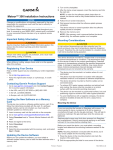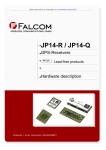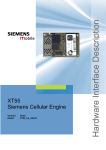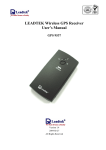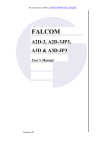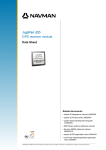Download "user manual"
Transcript
This document is available at HTTP://WWW.FALCOM.DE/ . JP7-T Family GPS-Receiver Hardware description Version 1.04 GPS-RECEIVER JP7-T VERSION 1.04 Contents 0 INTRODUCTION ..............................................................5 0.1 0.2 0.3 0.4 0.5 GENERAL ........................................................................................................................................ 5 SCOPE OF THE USER’S MANUAL ...................................................................................................... 6 USED ABBREVIATIONS .................................................................................................................... 7 RELATED DOCUMENTS.................................................................................................................... 7 ORDER OPTIONS.............................................................................................................................. 8 1 SECURITY .........................................................................9 1.1 1.2 1.3 1.4 1.5 GENERAL INFORMATION ................................................................................................................. 9 RESTRICTED USE............................................................................................................................. 9 CHILDREN ...................................................................................................................................... 9 OPERATION/ANTENNA .................................................................................................................... 9 ELECTROSTATIC DISCHARGE (ESD)............................................................................................. 10 2 SAFETY STANDARDS ...................................................11 3 GPS BASICS PRINCIPLE ..............................................12 3.1 SIGNAL PROCESSING OPERATION ................................................................................................. 12 4 TECHNICAL DATA........................................................13 5 DESCRIPTION OF OPERATING MODES .................15 5.1 5.2 5.3 5.4 5.5 NORMAL OPERATION ................................................................................................................... 15 TRICKLE POWER OPERATION ....................................................................................................... 15 PUSH-TO-FIX MODE ..................................................................................................................... 16 ADVANCED POWER MANAGEMENT (APM).................................................................................. 16 NMEA INPUT MESSAGE FOR TRICKLE POWER MODE................................................................... 21 6 TECHNICAL DESCRIPTION .......................................24 6.1 6.2 6.3 6.3.1 6.3.2 6.3.3 6.4 6.5 6.5.1 6.6 6.7 6.8 6.8.1 6.8.2 6.8.3 6.8.4 RECEIVER ARCHITECTURE ........................................................................................................... 24 DESCRIPTION OF GPS RECEIVING SIGNALS ................................................................................... 25 START-UP MODES ........................................................................................................................ 25 Cold start...................................................................................................................................... 25 Warm start ................................................................................................................................... 26 Hot start ....................................................................................................................................... 26 PRODUCT APPLICATIONS .............................................................................................................. 26 TECHNICAL SPECIFICATIONS......................................................................................................... 27 Electrical Characteristics ............................................................................................................. 27 HARDWARE INTERFACE ................................................................................................................ 29 BALLS ASSIGNMENT OF THE JP7-TB............................................................................................. 30 PIN ASSIGNMENT OF THE 50-PIN CONNECTOR ............................................................................... 33 Configuration and timing signals................................................................................................. 35 Serial communication signals ...................................................................................................... 36 DC input signals .......................................................................................................................... 37 General purpose input/output....................................................................................................... 38 7 SOFTWARE INTERFACE.............................................39 7.1 7.2 7.2.1 7.2.2 7.2.3 SIRF BINARY DATA MESSAGE....................................................................................................... 39 NMEA DATA MESSAGE ................................................................................................................ 41 NMEA output messages .............................................................................................................. 42 NMEA input messages ................................................................................................................ 42 Transport Message....................................................................................................................... 43 8 MECHANICAL DRAW ..................................................44 This confidential document is the property of FALCOM GmbH and may not be copied or circulated without permission. Page 2 GPS-RECEIVER JP7-T VERSION 1.04 9 LAYOUT RECOMMENDATION..................................47 9.1 9.2 GROUND PLANES .......................................................................................................................... 47 RF CONNECTION........................................................................................................................... 47 10 FIRST STEPS TO MAKE IT WORK............................50 11 APPENDIX .......................................................................53 11.1 11.2 11.3 11.4 11.4.1 11.4.2 BOARD-TO-BOARD CONNECTOR ................................................................................................... 53 RF CONNECTOR ............................................................................................................................ 53 FIRMWARE INTERFACE ................................................................................................................. 54 XTRAC FIRMWARE DESCRIPTION .................................................................................................. 54 SiRFXTrac2 firmwares default settings....................................................................................... 54 Order options ............................................................................................................................... 55 Version history Version number 1.00 1.01 Author Fadil Beqiri Fadil Beqiri 1.02 1.03 Fadil Beqiri Fadil Beqiri 1.04 Fadil Beqiri Changes Initial version The signal names of serial ports updated New section 0 “XTrac software description” added. CheckSum calculation added A complete update implemented. Chapter 11.3 updated. Chapter 5.4 added (APM mode). The serial ports of JP7-T family are 3.3 V CMOS only and not 5 V TTL compatible. The GPIO1-pin on all GPS units (operating with SiRFXTrac2 fimware) can be used to control the validity of GPS receiving data. See added note in chapter 6.8.4 The SiRFXTrac2 firmware is available in two versions, see updated chapter 11.4.1. The mechanical dimensions of the balls position on the JP7-TB/C receiver updated (see Figure 10 and Figure 12) This confidential document is the property of FALCOM GmbH and may not be copied or circulated without permission. Page 3 GPS-RECEIVER JP7-T VERSION 1.04 Cautions Information furnished herein by FALCOM is believed to be accurate and reliable. However, no responsibility is assumed for its use. Also the information contained herein is subject to change without notice. Please, read carefully the safety precautions. If you have any technical questions regarding this document or the product described in it, please contact your vendor. General information about FALCOM and its range of products is available at the following internet address: http://www.falcom.de/ Trademarks Some mentioned products are registered trademarks of their respective companies. Copyright The JP7-T family hardware description is copyrighted by FALCOM GmbH with all rights reserved. No part of this user’s guide may be produced in any form without the prior written permission of FALCOM GmbH. FALCOM GmbH. No patent liability is assumed with respect to the use of the information contained herein. This confidential document is the property of FALCOM GmbH and may not be copied or circulated without permission. Page 4 GPS-RECEIVER JP7-T VERSION 1.04 0 Introduction 0.1 General This description is focussed on the GPS receiver of the FALCOM JP7-T family from FALCOM GmbH. The JP7-T family is an excellent device designed and supports a wide variety of solutions regarding to the customer fulfilment, the wide variety of the JP7-T family offers easy integration in various ways on the user independent application platform. Regarding to the JP7-T family (which contains JP7-T, JP7-TB, JP7-TC-1(-2)) concept, there are three different GPS receivers with different options. This manual contains information about purpose and use of the GPS receivers included into the FALCOM JP7-T family. Please read this manual very carefully to avoid any mistakes and to secure an optimal use of the devices. Each GPS receiver in the JP7-T family is a single-board 12 parallel channel receiver intended as a component for OEM products. The FALCOM JP7-T family is based and advanced on the FALCOM JP7 GPS receiver which delivers major advancement in GPS performance, accuracy, integration, computing power and flexibility without modification regarding to the receiver form factor and pin-out. Each GPS receiver of the FALCOM JP7-T family has an integrated temperature compensated crystal oscillators (TCXO). Due to the higher stability of frequency it offers a highly improved performance. Additionally, a TCXO accept the condition for use the SiRFXTrac2 firmware. The JP7- T family using SiRFXTrac2 firmware is able to track the GPS signals at an extremely small level by 16 dBHz. In addition, higher sensitivity allows it more flexibility onits design, the placement of the antenna and the selection of the kind of antenna. The GPS receiver continuously tracks all satellites in view, thus providing accurate satellite position data. The highly integrated digital receiver uses the SiRFstarII-Low Power chipset. The internal GPS software completes the package providing flexible system architecture for standalone GPS based products. In order to save space on the application platform, the FALCOM JP7-T family comes as an extremely slim and compact module. This makes it ideally suited for a broad range of mobile computing devices, and particularly offers easy integration with smart phones, PDAs, and other handhelds. The FALCOM JP7-T family is also designed to be an entire product such as an AVL tracking unit, handheld GPS. Please consult SiRF (www.sirf.com) for special information about the SiRFstarII-Low Power chipset. Figure 1: The FALCOM JP7-T family GPS receiver (top, side and bottom view) This confidential document is the property of FALCOM GmbH and may not be copied or circulated without permission. Page 5 GPS-RECEIVER JP7-T VERSION 1.04 Users are advised to proceed quickly to the chapter "Security" and read the hints carefully to secure its optimal use. 0.2 Scope of the user’s manual This document describes the hardware interface and the technical specifications of the JP7-T. It is also the preliminary data sheet for the electrical and mechanical device application design. As far as JP7-T family concept is concerned, there are three different JP7-T GPS Receiver Modules available. The difference between these receivers can be recognized by looking on the bottom side of the module (see attached picture on the chapter 0.5 “Order option”). To choose a unit it depends on the customer requirements: JP7-T JP7-TB JP7-TC-1 JP7-TC-2 25.5535 MHz 25.5535 MHz built in built in built in Not available U.FL-R-SMT – plug antenna connector from Hirose. No RF connector. RF Part TCXO Active antenna power control RF connector 25.5535 MHz 25.5535 MHz built in Not available Solder pads, only Digital Part Connector Not available Not available 50-pin, Hirose DF12C, Board-ToBoard connector Balls Not available 48-Balls are available Not available 50-pin, Hirose DF12C, BoardTo-Board connector Not available In this manual user will not find separately description for each option of devices. The interfaces, pin-out and some application’s example are the same for all devices. This confidential document is the property of FALCOM GmbH and may not be copied or circulated without permission. Page 6 GPS-RECEIVER JP7-T VERSION 1.04 0.3 Used abbreviations Abbreviation Description DGPS Differential GPS DOP Dilution of Precision GPS Global Positioning System GGA GPS Fixed Data LNA Low Noise Amplifier NMEA National Maritime Electronics Association PRN Pseudo - Random Noise Number – The Identity of GPS satellites RF Radio Frequency RP Receive Protocol RTC Real Time Clock RTCM Radio Technical Commission for Maritime Services SDI Data input SDO Data output SA Selective Availability WAAS Wide Area Augmentation System MSK Minimum Shift Keying PCB Printed Circuit Board PRN Pseudo-random noise IF Intermediate Frequency A/D Analog/Digital 0.4 Related documents [1.] SiRF binary and NMEA protocol specification; http://www.falcom.de/service/downloads/manual/SiRF/SiRFmessages.pdf [2.] SiRF-demo software and manual; http://www.falcom.de/service/downloads/manual/SiRF/SiRFdemo.pdf http://www.falcom.de/service/downloads/manual/SiRF/SiRFdemo.zip This confidential document is the property of FALCOM GmbH and may not be copied or circulated without permission. Page 7 GPS-RECEIVER JP7-T VERSION 1.04 0.5 Order options Before you start up the receiver, make sure that your package includes the following items. If any item is missing or damaged, please contact your vendor immediately. According to your requirements you can choose the desired unit. In the figure below the available components are marked with red colour. (In order to have a clear view and to detect the required option of JP7-T family imaged below, please print this page with a colour printer.) The table below contains the order options of JP7-T family. Name Options JP7-T 30-pin out on the left and right side of JP7-T are available for use JP7-TB 48 Balls are available for use JP7-TC-1 JP7-TC JP7-TC-2 A 50-pin connector and a RF connector are available for use A 50-pin connector and solder pads for an antenna cable are available for use. There is no antenna cable included in the delivery package. This confidential document is the property of FALCOM GmbH and may not be copied or circulated without permission. Page 8 GPS-RECEIVER JP7-T VERSION 1.04 1 Security This chapter contains important information for the safe and reliable use of the GPS receiver. Please read this chapter carefully before starting to use the GPS receiver. 1.1 General information The Global Positioning System uses satellite navigation, an entirely new concept in navigation. GPS has become established in many areas, for example, in civil aviation or deep-sea shipping. It is making deep inroads in vehicle manufacturing and before long everyone of us will use it this way or another. The GPS system is operated by the government of the United States of America, which also has sole responsibility for the accuracy and maintenance of the system. The system is constantly being improved and may entail modifications effecting the accuracy and performance of the GPS equipment. 1.2 Restricted use Certain restrictions on the use of the GPS receiver may have to be observed on board a plane, in hospitals, public places or government institutions, laboratories etc. Follow these instructions. 1.3 Children Do not allow children to play with the GPS receiver. It is not a toy and children could hurt themselves or others. The GPS receiver consists of many small parts which can come loose and could be swallowed by small children. Thoughtless handling can damage the GPS receiver. 1.4 Operation/antenna Operate the GPS receiver with an antenna connected to it and with no obstruction between the receiver and the satellite. Make absolutely sure that the antenna socket or antenna cable is not shorted as this would render the GPS receiver disfunctional. Do not use the receiver with a damaged antenna. Replace a damaged antenna without delay. Use only a manufacturer-approved antenna. Use only the supplied or an approved antenna with your GPS receiver. Antennas from other manufacturers which are not authorized by the supplier can damage the GPS receiver. Technical modifications and additions may contravene local radiofrequency emission regulations or invalidate the type approval. Authorized GPS antennas: FAL-ANT-3 (active antenna) This confidential document is the property of FALCOM GmbH and may not be copied or circulated without permission. Page 9 GPS-RECEIVER JP7-T VERSION 1.04 1.5 Electrostatic Discharge (ESD) The JP7-T family GPS receiver contains class 1 devices. The following Electrostatic Discharge (ESD) precautions are recommended: - Protective outer garments. Handle device in ESD safeguarded work area. Transport device in ESD shielded containers. Monitor and test all ESD protection equipment. Treat the JP7-T family GPS receiver as extremely sensitive to ESD. This confidential document is the property of FALCOM GmbH and may not be copied or circulated without permission. Page 10 GPS-RECEIVER JP7-T VERSION 1.04 2 Safety standards The GPS receiver meets the safety standards for RF receivers and the standards and recommendations for the protection of public exposure to RF electromagnetic energy established by government bodies and professional organizations, such as directives of the European Community, Directorate General V in matters of radio frequency electromagnetic energy. This confidential document is the property of FALCOM GmbH and may not be copied or circulated without permission. Page 11 GPS-RECEIVER JP7-T VERSION 1.04 3 GPS basics principle 3.1 Signal Processing Operation The JP7-T family is designed to use L1 Frequency (C/A Code). The module is separated into four major parts: RF frequency down-converter, digital baseband demodulation, embedded ARM microprocessor and internal GPS software stored on-board (8 MBits) Flash-Memory. The RF frequency conversion and the baseband demodulation are executed by hardware while the embedded ARM processor computes the GPS Position, Velocity and Time solution employing the internal GPS software. ♦ The purpose of the RF circuitry is to reinforce the very weak (130dBm nominal) GPS signal, filters it and down-converts it to an Intermediate Frequency (IF) of 9.45MHz for digital processing. The JP7-T family architecture relies on the high level of integration in the RF part to significantly reduce part count and circuit complexity. The IF filter is built-in as well. ♦ The digital baseband demodulator takes the quantified GPS signal and detects the individual satellites serial data bit stream, along with the associated pseudo range. This action consists of removing spread spectrum and Doppler frequency components of the signal to obtain the serial data messages. ♦ The embedded ARM processor monitors channel allocation, extracts the raw satellite tracking data, computes the position and time solution and sends it on a serial port for high level applications to use or process it locally. Support functions for the microprocessor include real-time clock and reset pulse generator circuits. ♦ The internal GPS software monitors and allocates channels, computes the Position, Velocity and Time using the pseudo-range of the satellites and reformat the data to be output at the serial interface or used locally. The internal GPS software is a tasking based architecture driven by the 100ms interrupt generated by GSP2e internal hardware. This confidential document is the property of FALCOM GmbH and may not be copied or circulated without permission. Page 12 GPS-RECEIVER JP7-T VERSION 1.04 4 Technical data FEATURES - OEM single board 12 channel GPS receiver - size: JP7-T : JP7-TB : JP7-TC-1 : JP7-TC-2 : - weight: JP7-T : JP7-TB : JP7-TC-1 : JP7-TC-2 : - casing: Fully shielded - TCXO - 8Mbit FLASH memory - operating voltage: +3.3 V DC ±5 % - power consumption: 220 mW (continuous mode with Low Power chipset) - temperature range: -40 to +85 °C (operation, transportation and storage) - protocol: SDI1/ SDO1: NMEA 9600 baud, Msg.: GLL, GGA, RMC, VTG, GSV, GSA 8 data bits, no parity, 1 stop bit SDI2/ SDO2: RTCM, 9600 baud The default Mode of FALCOM JP7-T is continuous Mode, but the user can set FALCOM JP7-T into the Trickle Power Mode via input command message. The FALCOM JP7-T family enters the trickle power mode corresponding to figure 2 (800 ms OFF Time and 200 ms ON Time) as soon as valid GPS data are available. As a result the average power consumption is reduced by approximately 80 % (approximately 150 mW). The settings for the trickle power mode can be modified by using the SiRFstar demo software. For example if the FALCOM JP7-T is configured to enter the OnTime mode each 10 s for a duration of 200 ms the - trickle power mode: 25,4 x 25,4 x 3 mm (L x B x H) 25,4 x 25,4 x 3.3 mm (L x B x H) 25,4 x 25,4 x 5.2 mm (L x B x H) 25,4 x 25,4 x 5.2 mm (L x B x H) 2,5 g (without shielding) 2,5 g (without shielding) 2,5 g (without shielding) 2,5 g (without shielding) This confidential document is the property of FALCOM GmbH and may not be copied or circulated without permission. Page 13 GPS-RECEIVER JP7-T VERSION 1.04 average power consumption can be reduced up to approx. 95 % (approx. 15 mW, ca. 4,8 mA at Vcc=3.3 V). For more details see chapter 5 “Operating modes”. Figure 2: Example for the trickle power mode of FALCOM JP7-T family This confidential document is the property of FALCOM GmbH and may not be copied or circulated without permission. Page 14 GPS-RECEIVER JP7-T VERSION 1.04 5 Description of operating modes There are three basic operating modes in which the JP7-T family operates during use. Each mode is used to accomplish a different task during the process of acquiring and maintaining the GPS information. The FALCOM JP7-T family designs include all the functionality necessary to implement the three different modes of operation. The default mode of JP7-T family is normal mode (continuous mode). Three different operating modes are described below. Additionally, two of them are designed as low-power mode consumption such as the Trickle Power mode and Push-To-Fix mode. The JP7-T family (JP7-TX) operating with SiRFXTrac software do not support Trickle Power and Push-To-Fix operations. The SiRFXTrac software, known as firmware supports another operation mode as far as the low power consumption is recognized, which is identified as APM mode (Advanced Power Management), for more information see chapter 5.4. 5.1 Normal Operation In this default implementation of normal mode the JP7-T family is fully powered and performs the function of signal search, acquisition, measurement and satellite tracking. The amount of time spent in the initial full power is dependent on the start condition that applies the number of satellites for which the ephemeris must be collected and the time to calibrate the RTC as well as the location of the GPS antenna (which must have an unobstructed view to the sky in order to receive the satellite radio transmissions). When the JP7-T family has been locked-on to at least four satellites, the receiver is able to calculate its current positions. In this mode the JP7-T family is fully powered and satellite searching, initial acquisition, initial position calculation and tracking measurement functions are always performed. In order to reduce the start up time of the receiver it is preferable to be connected to an external back up battery, so that the RTC is running during the power interrupt. The backup power is required for retention of SRAM memory and maintaining the Real-Time-Clock. The validity of data stored in SRAM is kept due to RTC keeps running and these data will be needed on the next power up scenario. 5.2 Trickle Power Operation In the Trickle Power mode, power is still applied to the JP7-T family, but the GPS engine is shut off and RF circuits are powered down. The Trickle Power mode provides a method of operating the JP7-T family in a user programmable duty cycle, consisting of a receiver measurement on time tracking and an interval of position update, thereby reducing the average power consumption over a period of time. The transition into the Trickle Power mode of JP7-T family can be implemented and configured by using the Set Operating Mode command in SiRFdemo. Between two on time tracking periods the JP7-T family sets itself in the sleep phase in other words into the low power consumption. The transition from sleep mode of JP7-T family back to the on time tracking is generated through the internal RTC which transmits a wake up signal to the GPS engine to switch it on as This confidential document is the property of FALCOM GmbH and may not be copied or circulated without permission. Page 15 GPS-RECEIVER JP7-T VERSION 1.04 well the RF circuit is powered on. The JP7-T is waked up and begins to acquire the on view satellites. In order to reduce the start up time of the receiver for the next power up is preferable to connect an external back up battery, so that the RTC is running during the power interrupt and the required data and the Trickle Mode configuration are kept from previous operation. If the receiver fails to acquire satellites within a given period of time (approx. 150 sec), the receiver sets itself into the sleep phase. The duration of this sleep phase is approx. 30 sec. After that, the receiver wakes up, resets itself and tries to acquire satellites which are in view. This procedure repeats itself until the initial position computation of GPS receiver is completed. Hint: After initial turn on or system reset, the JP7-T will remain in the full power tracking until a series of Kalman filter navigation solution is obtained, all ephemeris data is collected and the RTC is calibrated prior to transitioning to the low power duty cycle mode. 5.3 Push-to-Fix Mode The Push-to-Fix mode puts the FALCOM JP7-T family into a background duty cycle which provides a periodic refresh of position, receiver time, ephemeris data and RTC calibration every 30 minutes. The Push-to-Fix mode is similar but executive from Trickle Power mode, meaning that only one mode can be set at a time. In this mode the receiver sets itself into the sleep phase for 29.5 minutes and a full tracking phase for 30 seconds. During the tracking phase the JP7-T family acquires satellites, computes position and updates ephemeris data as well the RTC is being calibrated. The transition into the Push-to-Fix mode of JP7-T family can be implemented and configured by using the Set Operating Mode command in SiRFdemo. During the subsequent background cycles or when a user requests a position update (the RESET_N has to be used) a reset is generated and a hot start will be typically performed which may take up to a maximum of 8 seconds. The receiver wakes up, computes its position fix and goes back to the previous sleep phase again. 5.4 Advanced Power Management (APM) SiRFXTrac version 2.0 supports a form of software power management called Advanced Power Management (APM). Please note that the Trickle Power and Push-to-Fix modes described on the chapters 5.2 and 5.3 here are not supported. APM is a software power management solution designed to reduce the overall power consumption of the JP7-T family (JP7-TX) operating with SiRFXTrac version 2.0 software. The actual operation of APM and power saving is very dependant on two things: 1. The available satellite signal strength, • Available signal strength will effect the behavior of APM as APM will keep the receiver operating in full power until a position fix is possible before shutting down to conserve power. The lower the signals available, the longer the receiver must remain on to obtain a position fix. This confidential document is the property of FALCOM GmbH and may not be copied or circulated without permission. Page 16 GPS-RECEIVER JP7-T VERSION 1.04 2. and whether power consumption has priority over the expected time between fixes • If power consumption (or duty cycle) is priority, the receiver will monitor the on-time and then set subsequent off-times to maintain the designated duty cycle. In changing signal environments, variable time between fixes can be expected. If time between fixes is of priority, the receiver will maintain the expected time between fixes without maintaining duty cycle. In low signal environments, this may result in the receiver staying in full power to maintain time between fixes. By means of released SiRFdemo software version 3.61 from SiRF the user is able to configure this operation mode with desired setting. Figure below demonstrates the difference in operation between duty cycle and time between fixes priority operation in changing signal strength environments. All three graphs are explained as follows. • TBF means Time Between Fixes. The top graph of Figure above shows the GPS signal level as a function of time. At point 1, the signal level drops significantly which results in the GPS receiver requiring more time to acquire the signal and generate a fix after starting the next APM cycle. A receiver using Duty priority (middle graph) recognizes that the On Time of the current cycle is suddenly longer (point 2) such that to maintain the duty cycle the subsequent Off Time must also be longer. It can be seen that the TBF value in the Duty cycle case is variable although generally it will be constant for a given signal level. This confidential document is the property of FALCOM GmbH and may not be copied or circulated without permission. Page 17 GPS-RECEIVER JP7-T VERSION 1.04 In the TBF priority case (bottom graph), GPS recognizes (point 3) that it has missed sending out a fix when normally expected (after a TBF interval has elapsed). The GPS enters the full power mode because it knows that it cannot acquire a fix in the requested TBF time given the current signal conditions. Once the signal conditions improve, the GPS is allowed to enter the low power mode again. The Duty priority is designed to maximize battery life, and is primarily functional during signal conditions in which it may be difficult to provide navigation information. (i.e. low Cno on several of the satellites) The board will monitor the On Time of its current cycle and set its subsequent Off Time to maintain the indicated Duty Cycle. The effect of this is that the time between subsequent fixes (TBF) when Duty is selected is a variable number (generally stable when the signal conditions are not changing). The board will make no attempt to maintain the TBF in this case. The only exception is if the Off Time based on the On Time and Duty Cycle would result in a smaller TBF than requested by the user. If the user has selected the TBF priority, the behavior will be quite different. In general, the board will try to maintain the TBF. In certain situations, this could mean that the board will go to full power between subsequent fixes. Figure attached on this section demonstrates the concept behind duty cycle and TBF priority. The diagram is fairly simplistic and is meant only to show general behavior during a GPS signal power transition. During APM shutdown periods the GPS receiver will not be able to receive/transmit messages. To send any messages to the GPS receiver, and the GPS receiver to be able to process input messages, the user must wait until the next cycle of APM or a external reset has to be performed. However, the SiRF Binary Message, OkToSend will be used to indicate the start and end of each APM cycle. The following formula calculates the Off Time, a function of On Time and Duty Cycle: 1 – Duty Cycle Off Time = On Time · ----------------------Duty Cycle To implement the APM, certain parameters must be initialized in the APM module. These parameters are provided via the SiRF Binary APM message. The APM module will not engage until it has received all of the information. In some applications, it is possible to set up the default parameter values to provide APM operation without the entry of the APM message. Table below describes the SiRF Binary APM parameters. APM parameters: Parameter Name Bytes Message ID APM_ ENABLED Num Fixes 1 1 Bit 0 1 Scale Example Units 0x35 TRUE FALSE Description SiRF Software (See figure Figure 4) 1 2 53 decimal APM Enable/Disable flag. Bits 1..7 reserved for expansion. Number of requested APM 3 cycles. May have one or more fix per cycle. This confidential document is the property of FALCOM GmbH and may not be copied or circulated without permission. Page 18 GPS-RECEIVER JP7-T VERSION 1.04 TIME_BTW_ FIXES Spare Byte 1 HORI_ERR_ MAX 1 1 1 See Table VERT_ERR_ MAX 1 See Table RESP_TIME_ MAX 1 TIME_ACC_ PRIORITY 1 Bits 0..1 POWER_ DUTY_CYCL E 1 TIME_DUTY _CYCLE 1 Bits 0..1 Spare Byte 2 1 1. 2. 3. 1 1 5 1 = 5% 3 = 15% Range 0->2551. Seconds Time between requested fixes. Range 10->180. Reserved for expansion. Maximum requested horizontal error. GPS shall try to provide a position with horizontal error less than this specified value in 95% of the cases. Maximum requested vertical error. GPS shall try to provide a position with vertical error less than this specified value in 95% of the cases. Not used, reserved for expansion. Seconds Maximum response time. GPS shall try to provide a position within the specified time. Not used, reserved for expansion. 0x00 = No priority imposed. 0x01 = RESP_TIME_MAX has higher priority. 0x02 = HORI_ERR_ MAX has higher priority. Bits 2..7 reserved for expansion. Not used currently, reserved for expansion. Percent Power Duty Cycle, defined as the time in full power to total operation time. 1->20; duty cycle (%) is this value *52. Time/Power Duty cycle priority. 0x01 = Time between two consecutive fixes has priority. 0x02 = Power Duty cycle has higher priority. Bits 2..7 reserved for expansion. Reserved for expansion. 4 5 6 7 8 9 10 11 12 A value of zero for the NUM_FIXES value indicates that continuous APM cycling is requested. APM will continue to cycle until power is removed or a new APM command is received. The bounds for the TIME_BTW_FIXES value for the APM is limited from 10 s to 180 s. This is slightly different than the message limits. This range may be expanded, or the next byte may be used for expansion to further extend this range in the future. If a duty-cycle of 0 is entered, it will be rejected as out of range. If a duty-cycle value of 20 is entered, the APM module will be disabled and continuous power operation will resume. Value Position Error (in meters) 0x00 0x01 0x02 0x03 0x04 0x05 0x06 0x07 0x08 < 1 meter < 5 meters < 10 meters < 20 meters < 40 meters < 80 meters < 160 meters No maximum Reserved This confidential document is the property of FALCOM GmbH and may not be copied or circulated without permission. Page 19 GPS-RECEIVER JP7-T VERSION 1.04 The GPS receiver accepts the SiRF input message specified in Hex format: <Message ID><space><APM_ENABLED><space>< Num Fixes> <space> <TIME_BTW_FIXES><space><Spare Byte 1><space><HORI_ERR_ MAX><space> <VERT_ERR_MAX> <space><RESP_TIME_MAX> <space> <TIME_ACC_PRIORITY> <space><POWER_ DUTY_CYCLE> <space> <TIME_DUTY_CYCLE<space><Spare Byte2> The input message is accepted if the GPS receiver operates in the SiRF binary mode, else the input message will be ignored. The APM mode cannot be implemented if the receiver operates in the NMEA mode. In order to set the receiver into the APM mode via SiRF input message, start the SiRFdemo software version 3.61, select the COM port where GPS receiver is connected and the baud rate to 38400 bps, then open the COM port. If the receiver is operating in NMEA mode, switch it to the SiRF binary mode, select Switch to SiRF protocol from the Action menu of main window. After the receiver has obtained a GPS fix, it is able to be set in the APM mode. To do this, open Action menu from main window and start Transmit Serial Message …. On the appeared dialog box type the following characters: 35 01 00 1E 00 06 06 00 00 0A 01 00 (do not forget to set the space character between 2 bytes) If the SiRF input message is correctly typed, click on Send button to place the receiver into APM mode. The SiRF input message above corresponds to the polled receiver configuration on figure below. The configuration can be polled by selecting Set Low Power … from the Action menu of main window, when the status of receiver is polled, its configuration is updated as shown in the figure below. Note that the GPS receiver can also be set into the APM mode using the following window. This window allows users easy and comfortable configuration of APM. Just select the mode to APM Enable option from the Mode group box. The APM mode of GPS can be configured according to your requirements. Click on Send button to place the receiver into APM mode with set operating parameters. The below schematic shows the structure and description of the APM-Mode input message. Figure 3: Structure of APM input message. This confidential document is the property of FALCOM GmbH and may not be copied or circulated without permission. Page 20 GPS-RECEIVER JP7-T VERSION 1.04 Regarding to the figure below (SiRFdemo software version 3.61, Low Power dialog box) a brief description is added in the table above (APM parameters). Please refer to the corresponding numbers assigned in the last column of the table above (APM parameters). Figure 4: Low power –XTrac dialog box. 5.5 NMEA input message for Trickle Power Mode The input command message below sets the FALCOM JP7-T family into the Trickle Power Mode or Push-To-Fix Mode. Details to configure Trickle Power Mode and Push-To-Fix Modes are described below. The receiver accepts the input message with following format: $PSRF107,<parameter>, <parameter> ,<parameter><* Checksum><CR> <LF>. COMAND SYNTAX $PSRF107, ptf, dc, msot *XX <CR><LF> DESCRIPTION Parameters description: ptf // numeric, performs the receiver in one of two pre-defined modes Possible values: 0: Set the receiver in Trickle Power mode 1: Set the receiver in Push-To-Fix mode dc // numeric, Duty Cycle in percent (%) Possible value: max 1000: Set the time which will be spent for tracking (dc% / 10) msot // numeric, the on Time in milliseconds Possible value 200.. 900: Set the time duration of each tracking period *XX // Checksum has to be calculated in hexadecimal. Example: $PSRF107,0,200,200*3D The receiver will be set in Trickle Power mode where 20% of time it will spend for tracking and the tracking period will takes 200 msec. Table 1: Example of Trickle Power Mode Control. Note: If the receiver is set into the Trickle Power Mode, the high data rate transmission is recommended as suitable. This confidential document is the property of FALCOM GmbH and may not be copied or circulated without permission. Page 21 GPS-RECEIVER JP7-T VERSION 1.04 Computation of Duty Cycle and On Time The Duty Cycle is the desired time, which will be spent for tracking. The On Time is the duration of each tracking period (range is 200 - 900 msec.) To calculate the Trickle Power update rate as a function of Duty Cycle and On Time, use the following formula: On Time – (Duty Cycle * On Time) Off Time = --------------------------------------------Duty Cycle Update rate = Off Time + On Time Hint: It is not possible to enter an On Time > 900 msec. Following are some examples of selections: Mode Continuous Trickle Power Trickle Power Trickle Power Trickle Power On Time (msec) 1000 200 200 300 500 Duty Cycle (%) 100 20 10 10 5 Update Rate (1/Hz) 1 1 2 3 10 Table 2: Example of Selections for Trickle Power Mode of Operation. Update Rates (seconds) On Time (msec) 200 300 400 500 600 700 800 900 1 2 3 4 5 6 7 8 9 10 √ √ √ √ √ √ √ √ √ √ √ √ √ √ √ √ √ √ √ √ √ √ √ √ √ √ √ √ √ √ √ √ √ √ √ √ √ √ √ √ √ √ √ √ √ √ √ √ √ √ √ √ √ √ √ √ √ √ √ √ √ √ √ √ √ √ √ √ √ √ √ √ √ √ √ √ √ Table 3: Trickle Power supported Modes. Push-To-Fix In this mode the receiver will turn on every 30 minutes to perform a system update consisting of a RTC calibration and satellite ephemeris data collection if required (i.e. a new satellite has become visible) as well as all software tasks to support SnapStart in the event of an NMEA. Ephemeris collection time in general takes 18 to 30 seconds If ephemeris data is not required then the system will re-calibrate and shut down. In either case, the amount of time the receiver remains off will be in proportion to how long it stayed on: On Period * (1-Duty Cycle) Off period = --------------------------------------------Duty Cycle This confidential document is the property of FALCOM GmbH and may not be copied or circulated without permission. Page 22 GPS-RECEIVER JP7-T VERSION 1.04 The off period has a possible range between 10 and 7200 seconds. The default is 1800 seconds. Comparison A comparison of the Trickle Power and Push-to-Fix modes is shown in Figure below. This diagram shows that for position update intervals less than approximately 600 seconds (i.e. rates faster than one fix per 10 minutes), the Trickle Power mode at an update interval of 10 seconds offers a lower power solution. The user would then be required to filter the output position data to use only the data points corresponding to the desired update interval. For example, if the desired position output is at 60 second intervals, then the user would only need one out of every six position outputs at a 10 second Trickle Power update interval. Alternatively, the user could perform smoothing or averaging of the position data and provide an output at the desired rate. This confidential document is the property of FALCOM GmbH and may not be copied or circulated without permission. Page 23 GPS-RECEIVER JP7-T VERSION 1.04 6 Technical Description 6.1 Receiver Architecture The JP7-T family OEM GPS receiver from FALCOM is a new OEM GPS receiver product that features the SiRFstarII-Low Power chipset. This completes 12 channels, WAAS-enabled GPS receiver provides a vastly superior position accuracy performance in a much smaller package. The SiRFstarII architecture builds on the high-performance SiRFstarI core, adding an acquisition accelerator, differential GPS processor, multipath mitigation hardware and satellite-tracking engine. The JP7-T family delivers major advancements in GPS performance, accuracy, integration, computing power and flexibility. Figure 5: Receiver architecture of the JP7-T family GPS receiver. Figure 5 above shows the block diagram of the JP7-T family architecture. This confidential document is the property of FALCOM GmbH and may not be copied or circulated without permission. Page 24 GPS-RECEIVER JP7-T VERSION 1.04 6.2 Description of GPS receiving signals When the GPS receiver is initially turned on, it begins to determinate its current positions, velocity and time. In order to perform a successful start it must have a current almanac, a reasonable expectation of its current location and a reasonable idea of the current time. When the Ephemeris data are completely collected, then satellite signals are tracked continuously and the position is calculated from time to time. While the receiver is trying to obtain a position fix, it needs to be locked-on to at least four satellites. In order to calculate quickly its current location, the receiver uses the current received signals, together with data from its memory (SRAM). The initial state of the receiver refers to the last status of the receiver in memory (SRAM). This essentially determines the length of time it will take for the receiver to obtain a GPS fix. Position can be quickly fixed within 8 seconds from a "hot-start" state, and typically 45 seconds from a "cold-start" state. The receiver uses the satellite signals to calculate its exact current location by calculating the receiver distance from the satellites. The position data within the receiver is then converted into latitude and longitude coordinates, which are usually provided in the geodetic datum on which the GPS is based (WGS84). 6.3 Start-Up Modes The start-up modes of the JP7-T family depend on the last stored position in the SRAM memory, such as the current time and ephemeris data. So that the JP7-T family can be initiated to one of three different start up procedures, but note that only one can be initiated at a time. In order to perform a Warm and Hot start, a backup battery has to be connected to the JP7-T family. Without an external backup battery the receiver will perform a cold start after every turn on. To achieve the faster start-up offered by a hot or warm start, a backup battery must be connected. To maximize battery lifetime, the battery voltage should not exceed the maximal supply voltage and should be between 2.85 V and 3.15 V. 6.3.1 Cold start The unit stores data about where the satellites are located at any given time. The data is called almanac. Occasionally, when the JP7-T family has been turned off for a long time, the almanac can get out-dated or “cold”. The cold start takes place when the receiver does not know its last position or time. In this start-up mode, the receiver either does not operate under back-up power conditions or it is the first start-up time (i.e. no idea about ephemeris or almanac data). At this time, the Ephemeris data has yet to be completely collected. Once the ephemeris data is collected from in view satellites, then the data from these satellites is considered valid and available for navigation. This start up scenario is one of the longest time which the receiver will take to obtain a GPS fix. This confidential document is the property of FALCOM GmbH and may not be copied or circulated without permission. Page 25 GPS-RECEIVER JP7-T 6.3.2 VERSION 1.04 Warm start This start-up procedure so called Warm start is performed when the time and position are known to within some limits, as well the almanac data are known and at least 3 Satellites Ephemeris are valid from previous operation. The validity of this data is dedicated if the receiver is switched off for more than 2 hours. If the receiver has been moved for more than 100 miles or the accurate time is currently not available then the Ephemeris data can be invalid. In such case the receiver will have to acquire the satellites and to collect the Ephemeris data which are in this scenario required. 6.3.3 Hot start This start-up procedure so called Hot start is performed when the time and position are accurately known, as well the almanac data are also valid. The validity of this data is dedicated if the receiver has been switched off for less than 2 hours and the real-time clock (RTC) has been operating during that switch off time. This start-up procedure performs computing of valid positions, only. The problems which may be met while start-up modes: The validity of the Real-time Clock (RTC) during start-up is determined in part through a checksum of the SRAM to see if it has been corrupted. If the SRAM checksum shows the memory has been corrupted, the RTC is also assumed to be invalid and the system ignores the RTC value. In this case, the system will not perform a hot start, but will fall back to a cold start mode with a longer time to first fix (TTFF), on the order of less than 45 seconds typical. These problems may happen in case of the RTC randomly drop counts under minimal supply voltage conditions which is supplied from external connected backup battery and supports the RTC operation (+3.0 VDC –5%). 6.4 Product applications - Handheld GPS receiver applications - Automotive applications - Marine navigation applications - Aviation applications - Timing applications This confidential document is the property of FALCOM GmbH and may not be copied or circulated without permission. Page 26 GPS-RECEIVER JP7-T VERSION 1.04 6.5 Technical specifications 6.5.1 Electrical Characteristics 6.5.1.1 General Frequency C/A code Channels L1, 1575.42 MHz 1.023 MHz chip rate 12 6.5.1.2 Accuracy Position Velocity Time time 10 meters CEP without SA 0.1 meters/second, without SA 1 microsecond synchronized to GPS 6.5.1.3 DGPS Accuracy Position Velocity 1 to 5 meters, typical 0.05 meters/second, typical 6.5.1.4 Datum WGS-84 6.5.1.5 Time to First Position* Hot start Warm start Cold start * < 4 sec., average < 35 sec., average < 45 sec., average The values listed above are available by using the SiRFXTrac2 firmware, only. 6.5.1.6 Sensitivity * Tracking Hot Start Warm Start Cold Start 16 dBHz 23 dBHz 28 dBHz 32 dBHz * The sensitivity value is specified at the correlator. On a JP7-T Evaluation Receiver using SiRFXTrac2 firmware with the supplied antenna, 32 dBHz is equivalent to 142 dBm or -172 dBW. Other board and antenna characteristics will vary. 6.5.1.7 Acquisition Rate Snap start Hot start Warm start Cold start < 3 sec., average < 8 sec., average < 38 sec., average < 45 sec., average This confidential document is the property of FALCOM GmbH and may not be copied or circulated without permission. Page 27 GPS-RECEIVER JP7-T VERSION 1.04 6.5.1.8 Dynamic Conditions Altitude Velocity Acceleration Jerk 18,000 meters (60,000 feet) max. <515 meters/second (1000 knots) max. 4 g, max. 20 meters/second³, max. 6.5.1.9 DC Power Main power Continuous mode Backup battery power + 3.3 V DC ±5 % 65 mA at 3.3 V DC +3 V DC ±5% 6.5.1.10 Serial Port Electrical interface Two full duplex serial communication, CMOS. Protocol messages SiRF binary and NMEA-0183, version 2.32 with a baud rate selection SiRF binary – position, velocity, altitude, status and control NMEA – GGA, GLL, GSA, GSV, RMC and VTG RTCM SC-104, version 2.32, type 1, 5 and 9 DGPS protocol 6.5.1.11 Time – 1PPS Pulse Level Pulse duration Time reference Measurements CMOS 100 ms At the pulse positive edge Aligned to GPS second, ± microsecond 6.5.1.12 TCXO-Specification Typical phase noise density Typical phase noise density Typical phase noise density Typical phase noise density Typical phase noise density Load sensitivity Long term stability 1 Hz offset 10 Hz offset 100 Hz offset 1 kHz offset 10 kHz offset ± 10% load change Frequency drift over 1 year -57.0 dBc/Hz -88.0 dBc/Hz -112.0 dBc/Hz -130.0 dBc/Hz -140.0 dBc/Hz 0.2 ± ppm 0.5 to 2.0 ± ppm This confidential document is the property of FALCOM GmbH and may not be copied or circulated without permission. Page 28 GPS-RECEIVER JP7-T VERSION 1.04 6.6 Hardware interface Pin Name I/O Description Level 1 VCC I Supply voltage 3.3 V DC±5 % 2 GND 3 BOOT_SELECT I Boots in update mode, if high CMOS 4 SDI1 I Serial Data Input A CMOS 5 SDO1 O Serial Data Output A CMOS 6 SDO2 O Serial Data Output B CMOS 7 SDI2 I Serial Data Input B CMOS 8 GPIO3 I/O See chapter 6.8.4 9 RF_ON O High if RF part on RF chip is on 10 GND Digital ground 11 RF_GND Analog ground 12 RF_GND Analog ground 13 RF_GND Analog ground 14 RF_GND Analog ground 15 RF_GND Analog ground 16 RF_GND Analog ground 17 RF_IN Digital ground I GPS signal from connected antenna CMOS 50 Ohms @ 1.575 GHz This confidential document is the property of FALCOM GmbH and may not be copied or circulated without permission. Page 29 GPS-RECEIVER JP7-T VERSION 1.04 Pin Name I/O Description Level 18 RF_GND 19 V_ANT I Power supply for active antenna upto +12 V DC 20 VC3.0 O Supply voltage of RF section +3.0 V DC 21 V_BAT I Power for RTC and SRAM +3 V DC ±5% 22 RESET_N I Resets the unit if active LOW CMOS 23 GPIO10 I/O See chapter 6.8.4 CMOS 24 GPIO6 I/O See chapter 6.8.4 CMOS 25 GPIO5 I/O See chapter 6.8.4 CMOS 26 GPIO7 I/O See chapter 6.8.4 CMOS 27 GPIO0 I/O See chapter 6.8.4 CMOS 28 GPIO1 I/O See chapter 6.8.4 CMOS 29 T-MARK O One pulse per second CMOS Analog ground (not supported by SiRFXTrac software) 30 GND Table 4: Digital ground Pin assignment of the JP7-T 6.7 Balls assignment of the JP7-TB Figure 6: Balls assignment of the JP7-TB This confidential document is the property of FALCOM GmbH and may not be copied or circulated without permission. Page 30 GPS-RECEIVER JP7-T VERSION 1.04 Ball Name I/O Description Level 1 GPIO1 I/O See chapter 6.8.4 CMOS 2 GPIO0 I/O See chapter 6.8.4 CMOS 3 GPIO7 I/O See chapter 6.8.4 CMOS 4 GPIO5 I/O See chapter 6.8.4 CMOS 5 GPIO6 I/O See chapter 6.8.4 CMOS 6 GPIO10 I/O See chapter 6.8.4 CMOS 7 RESET_N I Reset the unit, if Active Low CMOS 8 V_BAT I Power for RTC and SRAM +3 V DC ±5% 9 VC3.0 O Supply voltage of RF section + 3.0 V DC / max. 25 mA 10 V_ANT I Power supply for an active antenna Up to +12 V DC / max. 25 mA 11 RF_GND Analog ground 12 RF_GND Analog ground 13 RF_IN 14 GND Digital ground 15 GND Digital ground 16 GND Digital ground 17 GND Digital ground 18 GND Digital ground 19 GND Digital ground 20 GND Digital ground 21 GND Digital ground 22 GND Digital ground 23 GND Digital ground 24 GND Digital ground 25 GND Digital ground 26 GND Digital ground I GPS signal from connected antenna 50 Ohms @ 1.575 GHz This confidential document is the property of FALCOM GmbH and may not be copied or circulated without permission. Page 31 GPS-RECEIVER JP7-T VERSION 1.04 Ball Name I/O Description Level 27 GND Digital ground 28 GND Digital ground 29 GND Digital ground 30 GND Digital ground 31 Vcca O Control output for RF part + 2.85 V DC / max. 25 mA 32 GPIO3 I/O See chapter 6.8.4 CMOS 33 SDI2 I Serial Data Input B CMOS 34 SDO2 O Serial Data Output B CMOS 35 SDO1 O Serial Data Output A CMOS 36 SDI1 I Serial Data Input A CMOS 37 BOOT_SELECT I Boots in update mode, if high CMOS 38 GND 39 VCC I Main power supply + 3.3 V DC ±5 % 30 VCC I Main power supply + 3.3 V DC ±5 % 41 GND 42 RFPC1 O Control output for TricklePower Mode + 2.85 V DC / max. 25 mA 43 RFPC0 O Control output for TricklePower Mode + 2.85 V DC / max. 25 mA 44 GPIO15 I/O See chapter 6.8.4 CMOS 45 GPIO14 I/O See chapter 6.8.4 CMOS 46 GPIO13 I/O See chapter 6.8.4 CMOS 47 T-MARK O 1 PPS Time Mark Output CMOS Digital ground Digital ground (not supported by SiRFXTrac software) 48 GND Table 7: Digital ground Pin assignment of the JP7-TB This confidential document is the property of FALCOM GmbH and may not be copied or circulated without permission. Page 32 GPS-RECEIVER JP7-T VERSION 1.04 6.8 Pin assignment of the 50-pin connector Figure 7: Pin out of the interface connector on the JP7-TC-1(-2) Please note that, the JP7-TC-2 is without RF connector, and there is no antenna cable included in the delivery package. The pin assignment of 50pin connector described in the table below is the same as JP7-TC-1. PIN Name I/O Description Level 1 RFPC1 O Control output for TricklePower Mode + 2.85 V DC / max. 25 mA 2 RFPC0 O Control output for TricklePower Mode + 2.85 V DC / max. 25 mA 3 GPIO15 I/O See chapter 6.8.4 CMOS 4 GPIO14 I/O See chapter 6.8.4 CMOS 5 GPIO13 I/O See chapter 6.8.4 CMOS 6 T-MARK O 1 PPS Time Mark Output CMOS (not supported by SiRFXTrac software) 7 GPIO1 I/O See chapter 6.8.4 CMOS 8 GPIO0 I/O See chapter 6.8.4 CMOS 9 GPIO7 I/O See chapter 6.8.4 CMOS 10 GPIO5 I/O See chapter 6.8.4 CMOS 11 GPIO6 I/O See chapter 6.8.4 CMOS 12 GPIO10 I/O See chapter 6.8.4 CMOS 13 RESET_N I Reset the unit if Active Low CMOS This confidential document is the property of FALCOM GmbH and may not be copied or circulated without permission. Page 33 GPS-RECEIVER JP7-T VERSION 1.04 PIN Name I/O Description Level 14 V_BAT I Power for RTC and SRAM +3 V DC ±5% 15 V_BAT I Power for RTC and SRAM +3 V DC ±5% 16 GND Digital ground 17 GND Digital ground 18 GND Digital ground 19 GND Digital ground 20 VC3.0 21 GND 22 V_ANT 23 GND Digital ground 24 GND Digital ground 25 GND Digital ground 26 GND Digital ground 27 GND Digital ground 28 GND Digital ground 29 GND Digital ground 30 GND Digital ground 31 GND Digital ground 32 GND Digital ground 33 GND Digital ground 34 GND Digital ground 35 GND Digital ground 36 GND Digital ground 37 Vcca O Control output for RF part + 2.85 V DC / max. 25 mA 38 Vcca O Control output for RF part + 2.85 V DC / max. 25 mA O Supply voltage of RF section + 3.0 V DC / max. 25 mA Digital ground I Power supply for an active antenna Up to +12 V DC/ max. 25 mA This confidential document is the property of FALCOM GmbH and may not be copied or circulated without permission. Page 34 GPS-RECEIVER JP7-T VERSION 1.04 PIN Name I/O Description Level 39 GPIO3 I/O See chapter 6.8.4 CMOS 40 SDI2 I Serial Data Input B CMOS 41 SDO2 O Serial Data Output B CMOS 42 SDO1 O Serial Data Output A CMOS 43 SDI1 I Serial Data Input A CMOS 44 BOOT_SELECT I Boots in update mode, if high CMOS 45 VCC I Main power supply + 3.3 V DC ±5 % 46 VCC I Main power supply + 3.3 V DC ±5 % 47 VCC I Main power supply + 3.3 V DC ±5 % 48 VCC I Main power supply + 3.3 V DC ±5 % 49 VCC I Main power supply + 3.3 V DC ±5 % 50 VCC I Main power supply + 3.3 V DC ±5 % Antenna pads on the JP7-TC-2, only 1 RF_GND - Analog ground - 2 RF_IN I GPS signal from connected antenna 50 Ohms @ 1.575 GHz 3 RF_GND - Analog ground - Table 6: 6.8.1 Pin assignment of the JP7-TC-1(-2) Configuration and timing signals RESET_N This pin provides an active-low reset input to the board. It causes the board to reset and to start searching for satellites. If not utilized, this input pin may be left open. T-MARK This pin provides 1 pulse per second output from the board, which is synchronized to within 1 microsecond of GPS time. The output is a CMOS level signal. BOOT_SELECT Set this Pin to high (+3.3 V DC) for reprogramming the flash of the JP7-T (for instance updating a new firmware for the JP7-T ). RFPC0 RFPC0 pin is provided to the JP7-TB and JP7-TC module. This pin is a control output for the Trickle- This confidential document is the property of FALCOM GmbH and may not be copied or circulated without permission. Page 35 GPS-RECEIVER JP7-T VERSION 1.04 Power Mode. A possible circuit is shown in figure below. If the LED lights permanently the GPS receiver is searching satellites. Is the GPS receiver in Trickle-Power Mode, the LED flashes in rhythm, i.e. the GPS receiver receives valid positions data (see also figure 8). Note: By switched off Trickle power the LED will flash permanently. The reception of satellites data can be checked by using the TMark, however, can not be evaluated. Vcc = 3.3 V DC 330 Ω BC817 RFPC0 47 kΩ GND figure 8: The control output for Trickle-Power Mode. 6.8.2 Serial communication signals The board supports two full duplex serial channels. All serial connections are at CMOS levels. If you need different voltage levels, use appropriate level shifters, (e.g. MAX 3232 from Maxim) in order to obtain RS-232 compatible signal levels (se also chapter 10). All supported variable baud rates and all can be controlled from the appropriate screens in SiRFdemo software. You can directly communicate with a PC serial port. SDI1 This is the main receiving channel and is used to receive software commands to the board from SiRFdemo software or from user written software. SDI2 This is the auxiliary receiving channel and is used to input differential corrections to the board to enable DGPS navigation. SDO1 This is the main transmitting channel and is used to output navigation and measurement data to SiRFdemo or user written software. SDO2 For user’s application. This confidential document is the property of FALCOM GmbH and may not be copied or circulated without permission. Page 36 GPS-RECEIVER JP7-T VERSION 1.04 6.8.3 DC input signals VCC This is the main DC power supply for 3,3 V powered board JP7-T family. RF_IN Active antennas have an integrated low-noise amplifier. They can be directly connected to this pin (RF_IN). If an active antenna is connected to RF_IN, the integrated low-noise amplifier of the antenna needs to be supplied with the correct voltage through pin V_ANT. Caution: Do not connect or disconnect the antenna when the JP7-T family is running. Caution: The RF_IN is always fed from the input voltage on the V_ANT. Do not use any input voltage on this pin V_ANT This pin is an input and reserved for an external DC power supply for an active antenna. The antenna bias for an external active antenna can be provided in two ways to pin V_ANT. In order to use a 5 V or 12 V active GPS antenna, the V_ANT has to be connected to 5 V, 12 V external power supply respectively. The other possibility is available when you connect the VC3.0 output (which provides 3.0 V) to V_ANT, so that an antenna with 3.0 V supply voltage can be used. Hint: The input voltage on the V_ANT should be chosen according to the antenna to be used. Note: The GPS receiver JP7-T family has to be connected to an active GPS antenna with a max. current 25 mA. VC3.0 This pin is an output which provides +3.0 V DC, and can be connected to the V_ANT, to supply the connected GPS antenna. In Trickle Operation and Push-To-Fix operation, VC3.0 is switched off when the receiver sets itself into the sleep mode. When the receiver wakes up the VC3.0 is switched on. This confidential document is the property of FALCOM GmbH and may not be copied or circulated without permission. Page 37 GPS-RECEIVER JP7-T 6.8.4 VERSION 1.04 General purpose input/output Several I/O’s (GPIO0, GPIO1, GPIO3, GPIO5, GPIO6, GPIO7, GPIO10, GPIO13, GPIO14, GPIO15, please refer to the tables 4, 5, 6) of the CPU are connected to the hardware interface connector of the JP7-T family. They are reserved for customer specific applications. For example: − For realization of a SPI-Bus − For realization of an Antenna-indication. These pins are not supported by the current GPS firmware. Please note that, the GPIO1 pin on all GPS units operating with SiRFXTrac2 firmware (with NMEA 38400 Baud, only) is defined as an output pin and it controlls the validity of GPS receiving data. A possible circuit to use this pin is shown in figure below. If the LED flashes in rhythm the GPS receiver is searching satellites, i.e. the GPS receiver receives invalid position data. If the LED lights permanently, i.e. the GPS receiver receives valid positions data. Is the GPS receiver in APM Mode (assumed that a position fix already has been obtained, for more details refer to chapter 5.4 ), the LED lights permanently. When the GPS receiver wakes-up from the shut down to the full power mode, the LED flashes in rhythm and then it lights permanently if valid GPS positions data is being received. This confidential document is the property of FALCOM GmbH and may not be copied or circulated without permission. Page 38 GPS-RECEIVER JP7-T VERSION 1.04 7 Software interface The FALCOM JP7-T family supports NMEA-0183 and SiRF binary protocols. A short description of these protocols is provided herein. For more detailed information please refer to the SiRFstarII message set specification available in the section “service/downloads/manuals” at FALCOM home page. 7.1 SiRF binary data message Table 7 lists the message list for the SiRF output messages. Hex ASCII Name Description 0 x 02 2 Measured Navigation Data Position, velocity and time 0 x 03 3 True Tracker Data Not implemented 0 x 04 4 Measured Tracking Data Satellite and C/No information 0 x 06 6 SW Version Receiver software 0 x 07 7 Clock Status Current clock status 0 x 08 8 50 BPS Subframe Data Standard ICD format 0 x 09 9 Throughput Navigation complete data 0 x 0A 10 Error ID Error coding for message failure 0 x 0B 11 Command Acknowledgement Successful request 0 x 0C 12 Command No Acknowledgement Unsuccessful request 0 x 0D 13 Visible List Auto Output 0 x 0E 14 Almanac Data Response to Poll 0 x 0F 15 Ephemeris Data Response to Poll 0 x 10 16 Test Mode 1 For use with SiRFtest (Test Mode 1) 0 x 11 17 Differential Corrections Received from DGPS broadcast 0 x 12 18 Ok To Send CPU ON/OFF (Trickle Power) 0 x 13 19 Navigation Parameters Response to Poll 0 x 14 20 Test Mode 2 Additional test data (Test Mode 2) 0 x 1C 28 Nav. Lib. Measurement Data Measurement Data This confidential document is the property of FALCOM GmbH and may not be copied or circulated without permission. Page 39 GPS-RECEIVER JP7-T VERSION 1.04 Hex ASCII Name Description 0 x 1D 29 Nav. Lib. DGPS Data Differential GPS Data 0 x 1E 30 Nav. Lib. SV State Data Satellite State Data 0 x 1F 31 Nav. Lib. Initialization Data Initialization Data 0 x FF 255 Development Data Various status messages Table 7: SiRF Output Messages Table 8: lists the message list for the SiRF input messages. Hex ASCII Name Description 0 x 55 85 Transmit Serial Message User definable message 0 x 80 128 Initialize Data Source Receiver initialization and associated parameters 0 x 81 129 Switch to NMEA Protocol Enable NMEA message, output rate and baud rate 0 x 82 130 Set Almanac (upload) Sends an existing almanac file to the receiver 0 x 84 132 Software Version (Poll) Polls for the loaded software version 0 x 85 133 DGPS Source Control DGPS correction source and beacon receiver information 0 x 86 134 Set Main Serial Port Baud rate, data bits, stop bits and parity 0 x 87 135 Switch Protocol Obsolete 0 x 88 136 Mode Control Navigation mode configuration 0 x 89 137 DOP Mask Control DOP mask selection and parameters 0 x 8A 138 DGPS Mode DGPS mode selection and timeout value 0 x 8B 139 Elevation Mask Elevation tracking and navigation masks 0 x 8C 140 Power Mask Power tracking and navigation masks 0 x 8D 141 Editing Residual Not implemented 0 x 8E 142 Steady-State Detection – not used Not implemented This confidential document is the property of FALCOM GmbH and may not be copied or circulated without permission. Page 40 GPS-RECEIVER JP7-T VERSION 1.04 Hex ASCII Name Description 0 x 8F 143 Static Navigation Configuration for static operation 0 x 90 144 Poll Clock Status (Poll) Polls the clock status 0 x 91 145 Set DGPS Serial Port DGPS port baud rate, data bits, stop bits and parity 0 x 92 146 Poll Almanac Polls for almanac data 0 x 93 147 Poll Ephemeris Polls for ephemeris data 0 x 94 148 Flash Update On the fly software update 0 x 95 149 Set Ephemeris (upload) Sends an existing ephemeris to the receiver 0 x 96 150 Switch Operating Mode Test mode selection, SV ID and period 0 x 97 151 Set Trickle Power Parameters Push to fix mode, duty cycle and on time 0 x 98 152 Poll Navigation Parameters Polls for the current navigation parameters 0 x A5 165 Set UART Configuration Protocol selection, baud rate, data bits, stop bits and parity 0 x A6 166 Set Message Rate SiRF binary message output rate 0 x A7 167 Low Power Acquisition Parameters Low power configuration parameters 0 x B6 182 Set UART Configuration Obsolete Table 8: SiRF Input Messages 7.2 NMEA data message The SiRFstarIIe evaluation receiver is capable of outputting data in the NMEA-0183 format as defined by the National Marine Electronics Association (NMEA), Standard for Interfacing Marine Electronic Devices, Version 2.20, January 1, 1997. This confidential document is the property of FALCOM GmbH and may not be copied or circulated without permission. Page 41 GPS-RECEIVER JP7-T VERSION 1.04 7.2.1 NMEA output messages Table 9 lists all NMEA output messages supported by SiRFstarIIe evaluation receiver and a brief description. Option Description GGA Time, position and fix type data. GLL Latitude, longitude, UTC time of position fix and status. GSA GPS receiver operating mode, satellites used in the position solution and DOP values. GSV The number of GPS satellites in view satellite ID numbers, elevation, azimuth and SNR values. MSS (This message can be switched on via SiRFdemo software) Signal-to-noise ratio, signal strength, frequency and bit rate from a radio-beacon receiver. RMC Time, date, position, course and speed data. VTG Course and speed information relative to the ground. Table 9: 7.2.2 NMEA Output Messages NMEA input messages Message MID1 Description Set Serial Port 100 Set PORT A parameters and protocol Navigation Initialization 101 Parameters required for start using X/Y/Z2 Set DGPS Port 102 Set PORT B parameters for DGPS input Query/Rate Control 103 Query standard NMEA message and/or set output rate LLA Navigation Initialization 104 Parameters required for start using Lat/Lon/Alt3 Development Data On/Off 105 Development Data messages On/Off MSK Receiver Interface MSK Command message to a MSK radio-beacon receiver. Table 10: NMEA Input Messages 1. Message Identification (MID). 2. Input co-ordinates must be WGS84. 3. Input co-ordinates must be WGS84. This confidential document is the property of FALCOM GmbH and may not be copied or circulated without permission. Page 42 GPS-RECEIVER JP7-T Note: 7.2.3 VERSION 1.04 NMEA input messages 100 to 105 are SiRF proprietary NMEA messages. The MSK NMEA string is defined by the NMEA 0183 standard. Transport Message Start Sequence Payload Checksum End Sequence $PSRF<MID>1 Data2 *CKSUM3 <CR> <LF>4 1. Message Identifier consisting of three numeric characters. Input messages begin at MID 100. 2. Message specific data. Refer to a specific message section for <data>...<data>definition. 3. CHECKSUM is a two-hex character checksum as defined in the NMEA specification. Use of checksums is required on all input messages. 4. Each message is terminated using Carriage Return (CR) Line Feed (LF) which is \r\n which is hex 0D 0A. Because \r\n are not printable ASCII characters, they are omitted from the example strings, but must be sent to terminate the message and cause the receiver to process that input message. CheckSum The checksum is 15-bit checksum of the bytes in the payload data. The following pseudo code defines the algorithm used. Let message to be the array of bytes to be sent by the transport. Let msgLen be the number of bytes in the message array to be transmitted. Clearly to say, the string over which the checksum has to be calculated is between the “$” and “*” (without characters “$” and “*”). Index = first checkSum = 0 while index < msgLen checkSum = checkSum + message[index] checkSum = checkSum AND (215-1). Note: All fields in all proprietary NMEA messages are required, none are optional. All NMEA messages are comma delimited. This confidential document is the property of FALCOM GmbH and may not be copied or circulated without permission. Page 43 GPS-RECEIVER JP7-T VERSION 1.04 8 Mechanical draw 25.4 mm 3 mm 0.90 mm 2.24 mm The following chapters describe the mechanical dimensions of JP7-T family and give recommendations for integrating JP7-T family into the user application. Note that, the absolute maximum dimension for all modules (JP7-T, JP7-TB, JP7-TC-1, JP7-TC-2) is: 25.4 mm x 25.4 mm (L x B). Figure 9 shows the top view on JP7-T family (without connectors) and provides an overview of the mechanical dimensions of the board. Please note that, the JP7-T family has a dimension tolerance from ±0.1 mm. 25.4 mm Figure 9: The mechanical draw of the JP7-T family This confidential document is the property of FALCOM GmbH and may not be copied or circulated without permission. Page 44 GPS-RECEIVER JP7-T VERSION 1.04 22.20 mm 20.70 mm 19.70 mm 18.70 mm 17.20 mm 15.70 mm 14.20 mm 12.70 mm 11.20 mm 9.70 mm 8.20 mm 5.70 mm 23.70 mm 22.70 mm 21.70 mm 21.20 mm 20.20 mm 18.70 mm 17.20 mm 15.70 mm 14.20 mm 12.70 mm 11.20 mm 9.70 mm 8.20 mm 6.70 mm 5.20 mm 4.20 mm 3.70 mm 2.70 mm m m 1.70 mm 1. 00 Round ball diameter 2.20 mm 4.70 mm 3.20 mm 6.70 mm Figure 10 shows the bottom view on JP7-TB and provides an overview of the mechanical dimensions of the pointed balls. Square ball dimentions 2.20 mm Figure 10: The mechanical draw of the JP7-TB This confidential document is the property of FALCOM GmbH and may not be copied or circulated without permission. Page 45 GPS-RECEIVER JP7-T VERSION 1.04 12.7 mm 1.67 mm Figure 11 shows the bottom view on JP7-TC-1(-2) and provides an overview of the mechanical dimensions of the integrated 50-pin connector and RF connector. 50 26 1 25 RF Connector 12.7 mm 21.7 mm 3.20 mm 1.67 mm The mechanical draw of the JP7-TC-1 12.7 mm Figure 11: 50 26 1 25 12.7 mm RF antenna pads 20.25 mm 21.7 mm 23.20 mm O 1.00 mm 2.20 mm Round ball Square pads for an antenna cable 1.05 mm Figure 12: The mechanical draw of the JP7-TC-2 This confidential document is the property of FALCOM GmbH and may not be copied or circulated without permission. Page 46 GPS-RECEIVER JP7-T VERSION 1.04 9 Layout recommendation 9.1 Ground planes JP7-T GPS receiver needs two different ground planes. The pins RF_GND (Pins 11, 12, 13, 14, 15, 16, 18) shall be connected to analog ground, the pins GND (Pins 2, 10, 30) to digital ground. The two ground planes shall be separated : ♦ the planes are connected inside the receiver (see Figure 13). connected internally Digital GND Analog GND Figure 13: Ground plane of the JP7-T family GPS receiver 9.2 RF connection The JP7-T family GPS receiver is designed to be functional by using either a passive patch antenna or an antenna connector with standard RF cables. In order to make a RF connection properly, the user has to connect the antenna points or the pins of the connector to the RF pin (pin 17) and RF grounds (GND’s of RF part), respectively (see Figures 13 and 14) RF connector feed Figure 14: RF connection to antenna feed of the JP7-T GPS receiver. This confidential document is the property of FALCOM GmbH and may not be copied or circulated without permission. Page 47 GPS-RECEIVER JP7-T VERSION 1.04 To make a proper antenna connection to the antenna pads (available on bottom side of JP7-TC-2, only) refer to the figure below which shows their position and pin name (refer also to table 6). Figure 15: RF connection to antenna feed of the JP7-TC-2 GPS receiver. Recommendations for layout, and soldering. Please note that, the dimension tolerance is ±0.1 mm. 2.0 0.8 1.9 2.8 25.4 1.277 1.5 25.4 Figure 16: Recommendations for layout. This confidential document is the property of FALCOM GmbH and may not be copied or circulated without permission. Page 48 GPS-RECEIVER JP7-T VERSION 1.04 Recommended soldering reflow profile for JP-T family mounting on PCB 10 sec. 240 ° C 250 3-5 ° C / sec Temperature 200 1-5 ° C / sec 150 Preheating 100 sec. 100 3-9 ° C / sec 50 200 - 220 sec. Time (sec) Figure 18: Typical solder conditions (temperature profile, reflow conditions). Consider a long time in the soldering zone (with temperature higher than 180°C) has to be kept as short as possible to prevent component and substrate damages. Peak temperature must not exceed 240°C. JP7-T family are able to withstand twice the previous recommended reflow profile in order to be compatible with a double reflow when SMDs are mounted on both sides of the PCB. A maximum of two soldering reflows is allowed for these packages. The use of a no clean flux is highly recommended to avoid any cleaning operation. In order to prevent any bump cracks, ultrasonic cleaning methods are not recommended. This confidential document is the property of FALCOM GmbH and may not be copied or circulated without permission. Page 49 GPS-RECEIVER JP7-T VERSION 1.04 10 First steps to make it work Figure 17 : The minimum hardware interface of JP7-T to get started. - Antenna: The antenna connection is the most critical part of PCB routing. Previously placing the JP7-T on the PCB secure that the connection to the antenna signals is routed. In order to make it properly functional a control impedance line has to connect the RF_IN signal with antenna feed points or antenna connector, respectively. The routing on the PCB depends on your choice. - Power: - Serial Interface: The JP7-T family provides two serial interfaces. Each interface is provided with two-wire the SDI1, SDO1 supports line and ground for the first serial interface (port A) and SDI2, SDO2 supports line and ground for the second serial interface (port B). These pins are 3.3 V CMOS compatible. In order to use different voltage levels, an appropriate level shifters has to be used. E. g. in order to provide RS232 compatible levels use the 3 V compatible MAX3232 transceiver from Maxim or others based on the required levels. The GPS data will be transmitted through port A (first serial port), if an active antenna is connected, which has a good view to sky (no obstacle). You The input power is also very important as far as the minimum and maximum voltage is concerned. The power supply of JP7T family has to be a single voltage source of VCC at 3.3 VDC. The power supply has to be able to provide a sufficient current which typically rises to 200 mA. Please, connect GND pins to ground, and connect the line which supplies the VCC pin to +3.3 V, properly. If they are correctly connected, the board is full powered and the unit begins obtaining its position fix. This confidential document is the property of FALCOM GmbH and may not be copied or circulated without permission. Page 50 GPS-RECEIVER JP7-T - - VERSION 1.04 can use port B (second serial port) to feed in DGPS correction data. Pull-up (100 kΩ) unused SDI inputs. Active Antenna Bias Voltage: The output voltage at the antenna cable can be used to power the bias voltage of the antenna, provided can make sure that the antenna runs down to 2.7 V bias voltage and the current does not exceed 20 mA. Backup Battery: In order to allow the GPS receiver to perform internally the warm and hot start it is advisable to connect the V_BAT pin to an external backup battery. For more information on cold, warm, and hot-start scenarios, please refer to the Section 6.3 “ Start-Up”. In case of a power interruption on pin VCC the real-time clock and backed-up SRAM are continually supplied through V_BAT. The voltage at this pin has to be +3 V DC ±5%. If you do not use a backup battery, connect this pin to GND or leave it open. Do not use a super cap for the battery backup supply (recommended by SiRF). The quickest way to get first results with the JP7-T is to use the JP7-T Evaluation board together with the program SiRFdemo. Figure 18: JP7-T Evaluation board The Evaluation board contains: Evaluation Box - JP7-T sample with soldered antenna cable. - power supply (AC/DC adapter, Type FW738/05, Output 5VDC 1.3 A) - active GPS antenna (FAL-ANT-3) - RS232 level shifter - RS232 cable to your computer. - The Evaluation board with contained components is not included in the delivery package. In order to have one the users of JP7-T family have to purchase it. This confidential document is the property of FALCOM GmbH and may not be copied or circulated without permission. Page 51 GPS-RECEIVER JP7-T Figure 19: VERSION 1.04 Example of using of the SiRFdemo The SiRFdemo manual and software are available on the FALCOM Website for free download: Î www.falcom.de/service/downloads/manual/SiRF/SiRFdemo.pdf Î www.falcom.de/service/downloads/manual/SiRF/SiRFdemo.zip This confidential document is the property of FALCOM GmbH and may not be copied or circulated without permission. Page 52 GPS-RECEIVER JP7-T VERSION 1.04 11 Appendix 11.1 Board-to-board connector This chapter provides specifications for the 50-pin board-to-board connector that serves as physical interface to the host application. The receptacle assembled on the JP7-TC is type Hirose DF12C. Mating headers from Hirose are available in different stacking heights. Figure 20.a: Hirose DF12C receptacle on JP7-TC DF12C Figure 20.b: Header Hirose 11.2 RF connector The JP7-TC uses an ultra-miniature SMT antenna connector supplied from Hirose Ltd. The product name is: • U.FL-R-SMT The position of the antenna connector on the JP7-TC board has to be seen on bottom side on the upper right corner. Mating plugs and cables can be chosen from the Hirose U.FL Series. Examples are shown in figure below. For latest product information please contact your Hirose dealer or visit the Hirose home page, for example http://www.hirose.com. Figure 21: Mechanical dimensions of U.FL-R-SMT connector with U.FL-LP-040 plug This confidential document is the property of FALCOM GmbH and may not be copied or circulated without permission. Page 53 GPS-RECEIVER JP7-T VERSION 1.04 11.3 Firmware Interface The table below shows supported SiRF firmware versions in the JP7-T family devices. Supported SiRF internal firmware version GPS Receiver 2.20 2.32 SiRFXTrac2 SiRFDrive JP7-T X X - - JP7-TB X X - X JP7-TC-1 X X - X JP7-TC-2 X X - X JP7-TX - - X - JP7-TBX - - X X JP7-TCX-1 - - X X - - X X JP7-TCX-2 - The firmware is also supported from the unit, but the unit will not be delivered with that firmware. 11.4 XTrac firmware description The JP7-T family using SiRFXTrac2 software offers high position accuracy and fast Time-To-First-Fix (TTFF) than is currently possible with other autonomous GPS solution. This means that the JP7-T family will continue to determinate its positions or obtain an initial fix in places where previously not possible. When the GPS receiver loaded with SiRFXTrac2 is initially turned on, it begins to determinate its current positions, velocity and time which will be calculated from tracking the GPS signals at an extremely small level by 16 dBHz. While trying to calculate a position fix, the receiver needs to be locked-on to at least four satellites. Your position can be extremely quick fixed within 4 seconds instead of within 8 seconds using other GPS software from a "hot-start" state, and within 45 seconds from a "cold-start" state. As a general note, the SiRFdemo v3.61 supports the additional functionality and configuration of SiRFXTrac2. This software is now available on FALCOM’s Website for free download: Î www.falcom.de/service/downloads/manual/SiRF/SiRFdemo3.61.zip 11.4.1 SiRFXTrac2 firmwares default settings There are two SiRFXTrac2 firmware which can be delivered to the end-user upon user request: 1. SiRFXTrac2 firmware version with NMEA 38400 baud All GPS units which use this SiRFXTrac2 firmware version have the following settings on serial interfaces: SDI1/SDO1 (first serial port): This confidential document is the property of FALCOM GmbH and may not be copied or circulated without permission. Page 54 GPS-RECEIVER JP7-T VERSION 1.04 NMEA 38400 baud, Msg.: GLL, GGA, RMC, GSV, GSA and VTG 8 data bits, no parity, 1 stop bit SDI2/SDO2(second serial port): RTCM, 38400 baud 2. SiRFXTrac2 firmware version with NMEA 4800 baud All GPS units which use this SiRFXTrac2 firmware version have the following settings on serial interfaces: SDI1/SDO1 (first serial port): NMEA 4800 baud, Msg.: GLL, GGA, RMC, GSV, GSA without VTG 8 data bits, no parity, 1 stop bit SDI2/SDO2(second serial port): RTCM, 4800 baud 11.4.2 Order options JP7-TCX As far as the SiRFXTrac2 firmware is concerned the products listed below with specific requirements are also available upon request: Name Using firmware version Options JP7-TX SiRFXTrac2 30-pin out on the left and right side of JP7-T are available for use JP7-TBX SiRFXTrac2 48 Balls are available for use SiRFXTrac2 A 50-pin connector and a RF connector are available for use SiRFXTrac2 A 50-pin connector and solder pads for an antenna cable are available for use. There is no antenna cable included in the delivery package. JP7-TCX-1 JP7-TCX-2 This confidential document is the property of FALCOM GmbH and may not be copied or circulated without permission. Page 55























































